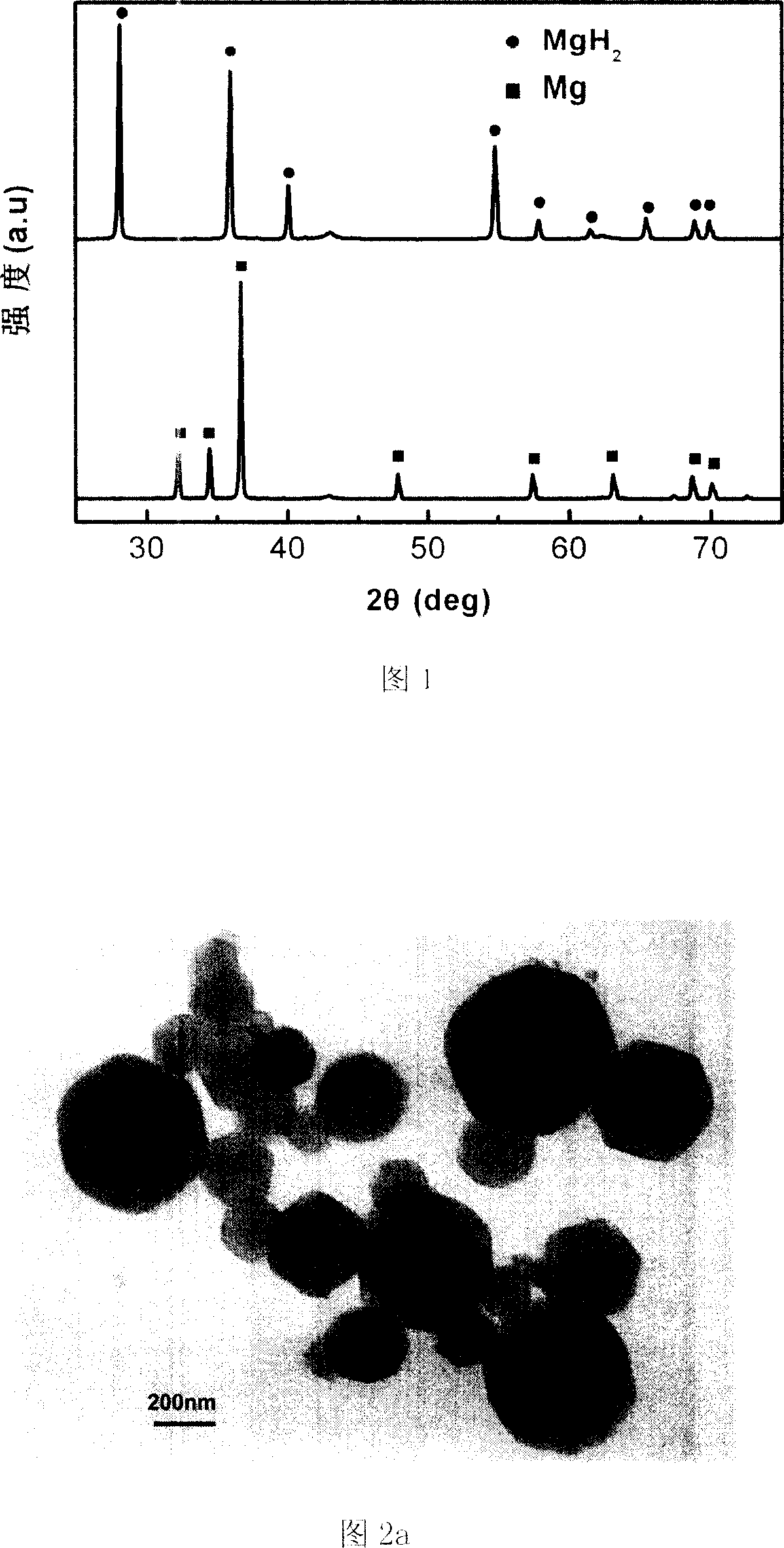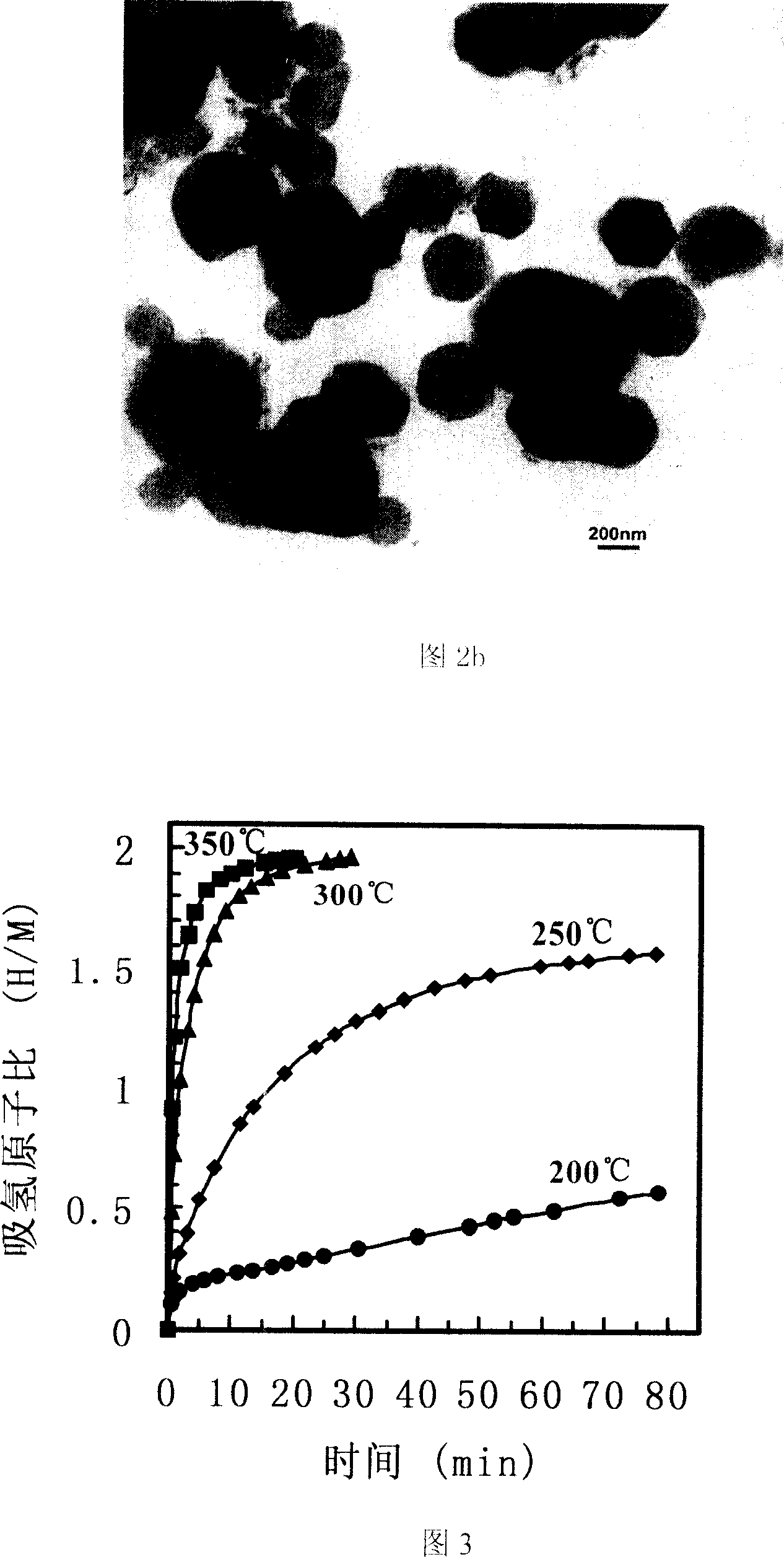Magnesium hydride nano particle and preparation method and application thereof
A technology of magnesium hydride and particles, applied in the direction of alkali metal/alkaline earth metal/beryllium/magnesium hydride, etc., to achieve excellent hydrogen absorption and desorption kinetic properties, large specific surface area, and improve the effect of hydrogen absorption and desorption kinetic properties
- Summary
- Abstract
- Description
- Claims
- Application Information
AI Technical Summary
Problems solved by technology
Method used
Image
Examples
Embodiment 1
[0017] Embodiment 1, synthetic MgH 2 nanoparticles
[0018] (1) The magnesium block is placed in a hydrogen plasma arc heating furnace, and after vacuuming, under an Ar atmosphere with a total pressure of 0.8 bar, a DC arc plasma is applied to evaporate the magnesium by heating and condense to nanoparticles.
[0019] (2) Stop heating and vacuumize. After the system cools down, slowly pass air into the furnace for passivation, and take out the sample after 48 hours of passivation.
[0020] (3) Put the prepared Mg particles into a hydrogen reaction furnace. After the system is evacuated, heat to 400°C, activate for 1 hour, pass in 40bar hydrogen for 4 hours, and cool to room temperature to obtain a particle size of nanometer. magnesium hydride particles.
Embodiment 2
[0021] Embodiment 2, synthetic MgH 2 nanoparticles
[0022] (1) Put the magnesium block in the hydrogen plasma arc heating furnace, and after vacuuming, the total pressure is 0.9bar in 40% N 2 Under a mixed atmosphere of Ar / Ar, DC arc plasma was applied to vaporize magnesium and condense it into nanoparticles.
[0023] (2) Stop heating and vacuumize. After the system cools down, slowly pass air into the furnace for passivation, and take out the sample after 48 hours of passivation.
[0024] (3) Put the prepared Mg particles into a hydrogen reaction furnace. After the system is evacuated, heat it to 350°C, activate it for 2 hours, pass in 10 bar hydrogen gas for 12 hours, and cool it to room temperature to obtain a particle size of nanometer. magnesium hydride particles.
Embodiment 3
[0025] Embodiment 3, synthetic MgH 2 nanoparticles
[0026] (1) The magnesium block is placed in a hydrogen plasma arc heating furnace, and after vacuuming, the total pressure is 0.5bar in 40%H 2 Under a mixed atmosphere of Ar / Ar, DC arc plasma was applied to vaporize magnesium and condense it into nanoparticles.
[0027] (2) Stop heating and vacuumize. After the system cools down, slowly pass air into the furnace for passivation, and take out the sample after 48 hours of passivation.
[0028] (3) Put the prepared Mg particles into a hydrogen reaction furnace. After the system is vacuumed, heat it to 450°C, activate it for 1 hour, pass in 40bar hydrogen gas for 2 hours, and cool it to room temperature to obtain a particle size of nanometer. magnesium hydride particles.
[0029] Fig. 1 is the product Mg and MgH of above-mentioned experiment 2 The XRD (X-ray powder diffraction) figure, it can be clearly seen that the prepared magnesium hydride has higher purity and does not ...
PUM
| Property | Measurement | Unit |
|---|---|---|
| diameter | aaaaa | aaaaa |
| particle diameter | aaaaa | aaaaa |
Abstract
Description
Claims
Application Information
 Login to View More
Login to View More - R&D
- Intellectual Property
- Life Sciences
- Materials
- Tech Scout
- Unparalleled Data Quality
- Higher Quality Content
- 60% Fewer Hallucinations
Browse by: Latest US Patents, China's latest patents, Technical Efficacy Thesaurus, Application Domain, Technology Topic, Popular Technical Reports.
© 2025 PatSnap. All rights reserved.Legal|Privacy policy|Modern Slavery Act Transparency Statement|Sitemap|About US| Contact US: help@patsnap.com


